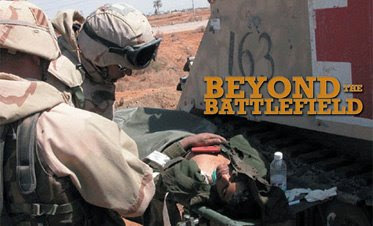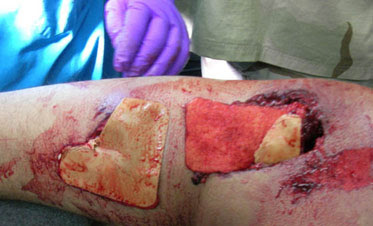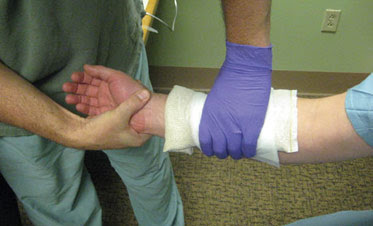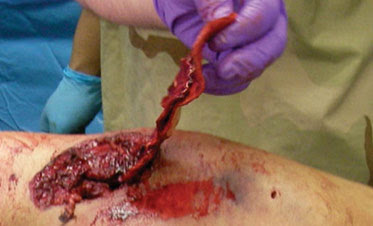 A soldier in Iraq receives treatment from a combat medic for gunshot wounds to his chest and arms. (Photo AP/Central Command)
A soldier in Iraq receives treatment from a combat medic for gunshot wounds to his chest and arms. (Photo AP/Central Command) Folks,
I was chatting with my son the other day about the use of hemostatic dressings in Iraq and he brought up the fact that the early ones were nasty about generating heat and actually causing more damage to the wound. The Army is in the process of further refining this amazing, life-saving technology for the battlefield, but an email from a fellow Irregular caused me to seek out this article on the civilian use of hemostatic dressings by stateside EMS personnel. You can find it here. Because I believe this subject is important, here is the article with some of the illustrations.
Beyond The Battlefield
The Use of Hemostatic Dressings in Civilian EMS
Jason Zeller, BS, NREMT-B, Adam Fox, DO, DPM, John P. Pryor, MD, FACS
March 2008 JEMS Vol. 33 No. 3
2008 Mar 1
Your BLS ambulance is dispatched for a hunting accident in a rural area. You and your partner arrive on scene to find that the patient is a 50-year-old male bleeding uncontrollably from the right side of his groin due to a rifle injury. He’s conscious and alert upon arrival; however, he’s tachycardic and hypotensive from continuous blood loss. You apply gauze and direct pressure to the wound and decide to immediately transport this patient due to significant blood loss.
Despite continuous direct pressure and pressure over the femoral pressure point, the bleeding continues. Your partner suggests a tourniquet, but the wound is high in the groin, and it’s impossible to get a strap above the bleeding site. What’s your next move?
Overview
One of the greatest threats with traumatic injury is massive bleeding ( 1 ). The basics of hemorrhage control continue to be direct pressure and ultimate surgical control. However, even with experienced providers, many patients still die of unrelenting hemorrhage.
In the military setting, where hemorrhage accounts for approximately 50% of all combat fatalities, adjuncts to direct pressure in the field include tourniquets and new hemostatic dressings. These adjuncts have proven invaluable for treating severe hemorrhage in soldiers injured during operations in Iraq and Afghanistan ( 2 ).
As of January 2008, 3,905 U.S. soldiers have been killed and 28,822 seriously wounded in Operation Iraqi Freedom alone. Combat wounds are often devastating and associated with massive tissue damage. New hemostatic dressings were specifically developed to address these types of wounds, taking into consideration the environment where they would be used.
 This photo shows a HemCon dressing applied to a combat wound by one of the authors (John Pryor). (Photo Courtesy John Pryor)
This photo shows a HemCon dressing applied to a combat wound by one of the authors (John Pryor). (Photo Courtesy John Pryor) In the U.S., however, where many trauma fatalities are also the direct result of exsanguination, there has been little change in hemorrhage control protocols that most often include only direct pressure and standard dressings. The success of these new hemostatic dressings on the battlefield should prompt all EMS agencies to consider their use in civilian practice.
Several similar dressings have been introduced during the past few years that have shown promise. All of them are bulky and serve to fill the space of large wounds. Most of the agents absorb water in some capacity, acting to concentrate the clotting factors in the blood and aid clot formation. Some of the most advanced dressings are engineered with human coagulation factors implanted into the dressing to promote fibrin formation, the last step in clot formation. The variation among available products lies in their substance (granular or solid), size and flexibility.
The ideal hemostatic agent would require little to no training, be in a pre-mixed, non-perishable state and have the ability to effectively control hemorrhage from any source. In addition, advantages would include being inexpensive, posing no risk to life or limb, and remaining stable and functional at extreme temperatures.
Currently, no single product meets all of these ideals; thus, the decision to use one product or formulation over another is an art as much as a science. The vast majority of these dressings are FDA approved as over-the-counter agents for external use. The following is an overview of the most commonly used products and formulations and their applications.
QuikClot
One of the longest on the market, QuikClot from Z-Medica is a mineral zeolite powder with a three-dimensional structure similar to a honeycomb that allows it to sift molecules by size. When QuikClot comes in contact with blood, it preferentially takes in smaller molecules (i.e., water), leaving the larger clotting factors and platelets behind in the wound ( 3 ). This results in a highly concentrated form that promotes coagulation.
QuikClot has been FDA approved under a few different formulations to be externally used to stop moderate to severe bleeding. The initial product showed reasonable promise for hemorrhage control, but several factors limited its application for day-to-day use. The most significant of these problems was an exothermic (heat-producing) reaction that occurred with its application. The temperature rise was significant enough to result in a burn-like injury to surrounding tissue about 2% of the time. Additionally, the original formulation was a granular powder that was difficult to handle and remove surgically once hemostasis was achieved.
In 2005 and 2006, Z-Medica re-engineered the product and introduced new formulations that addressed these problems. The new QuikClot 1st Response and QuikClot ACS+ are no longer associated with any significant exothermic reaction and allow for easier application and removal. One published study demonstrated the efficacy of the new formulations ( 4 ).
The product is currently used in combat operations, specifically with the U.S. Army, Navy, Air Force and Marine Corps. For civilian use, the product is packaged in several forms: QuikClot 1st Response is available in three sizes (25-, 50- and 100-gram sponges) designed specifically for EMS/first responders. QuikClot Sport and Sport Silver are over-the-counter versions being marketed to non-medical personnel.
The advantage of the new QuikClot ACS+ formulation is its ability to fill large wounds and cover large surface areas. It doesn’t work well for small, deep wounds, such as small-entry penetrating wounds. In the personal experience of the authors, the products have been easy to use and remove during surgery and showed no heat production.
 After a wound has been packed with a hemostatic dressing, apply direct pressure. (Photo Courtesy John Pryor)
After a wound has been packed with a hemostatic dressing, apply direct pressure. (Photo Courtesy John Pryor) HemCon
An engineered chitosan preparation derived from Poly-N-acetyl glucosamine, HemCon from HemCon Medical Technologies is biodegradable and non-toxic. Chitosan has been shown to have mucoadhesive properties that make it an ideal hemostatic agent. The HemCon dressing is a freeze-dried chitosan dressing, designed to optimize the mucoadhesive surface density and structural integrity of chitosan at the site of the injury.
Essentially, the bandage works by becoming extremely sticky when in contact with blood. The adhesive-like action seals the wound and controls the bleeding. The chemical makeup of the dressing, with its positive charges, attracts negatively charged red-blood cells. These cells create a seal as they’re drawn into the bandage, forming a tight adherent clot ( 5 ).
It first gained FDA approval in 2003, and its use has subsequently been reported mostly in the military, with more than four years of proven combat experience. The largest experience noted in the literature reported a 97% success rate at controlling bleeding on human subjects ( 6 ). A 2006 study recommended that HemCon be “the first advanced hemostatic dressing used in situations in which severe external bleeding can’t be controlled by standard methods.”2 Animal studies don’t necessarily support this success rate, and some dressing-to-dressing variability has been suggested.
The bandage is intended as a topical dressing for local management of bleeding but can be used temporarily for severe bleeding of surgical wounds and traumatic injury. The dressing shouldn’t be left in place longer than 24 hours. The bandage appears to be stable at extremes of temperature and doesn’t require special preparation or significant amounts of training for its use. There have been no known allergic reactions attributed to the dressing.
One of the authors has had significant experience with the product in combat care and feels it provides good hemorrhage control in large, open wounds. The material is inflexible, and thus the main disadvantage is difficulty using it in deep, narrow wounds.
 Surgeons remove a HemCon dressing from a patient with a combat wound. (Photo Courtesy John Pryor)
Surgeons remove a HemCon dressing from a patient with a combat wound. (Photo Courtesy John Pryor) In 2006, to address harder to reach, narrow wound track bleeding, HemCon released ChitoFlex, a stuffable, flexible dressing that can be torn or folded. In 2007, HemCon also released a more flexible, enhanced HemCon Bandage line to meet the needs of more narrow wounds.
Celox
From SAM Medical Products, Celox is another chitosan product that’s one of the newer hemostatics on the market. There have been no published reports to date on human use, but a live-tissue study and animal trials reported by company literature show promise. The material appears to control major arterial bleeding, doesn’t generate heat, can work at temperature extremes, is lightweight, portable and easy to administer without specialized training. The product comes in granular form that’s poured over the bleeding site where it gels and can then be removed easily.
Celox can be applied to deep, narrow wounds because of its granular form. And the Celox-A applicator and plunger delivery system helps the agent reach even deeper inside a penetrating wound.
In addition, it can be spread over large areas of open surface wounds. The granules coalesce into a coagulum that’s reported to lift off the wound easily during surgery.
Fibrin-Based Sealant
Collaboration between the U.S. Army and the American Red Cross has produced a dry fibrin-sealant dressing that represents the next generation of hemostatic products. The dressing contains human fibrinogen, human thrombin and calcium chloride freeze-dried onto a polyglactin-mesh backing. Conveniently, it can be used directly out of the packaging without any preparation.
Despite the human derivation of its components, there’s no risk of disease transmission, such as HIV and hepatitis. Moreover, the dressing is absorbable and doesn’t cause any local tissue reaction. In animal models, it has been shown to control both venous and arterial bleeding with excellent efficacy. Human studies are ongoing, however, so the dressing isn’t currently available and has yet to be FDA approved.
Application Procedure
It’s important to cover the entire bleeding surface, including the deep areas of the wound. Sometimes tissue will need to be splayed open to place the dressing into a deeper portion. If blood soaks through the first layer, a second layer of hemostatic can be placed. If the wound is deep, then abdominal battle dressings or gauze can be used on top of the hemostatic to give it bulk. A pressure dressing, either a roller bandage or ACE wrap, is sometimes used to hold the dressing in place.
Direct pressure from a provider should also be continued on top of the dressings. If needed, other adjuncts, such as pressure point activation or placement of a tourniquet, should be considered. Document the type and number of hemostatic dressings in your run report, and be sure to tell the receiving physician and nursing staff that hemostatics were used.
Recommendations for EMS Agencies
We recommend the adoption of hemostatic dressings in the standard protocols for hemorrhage control as an adjunct to elevation, direct pressure, pressure points and tourniquets. They should not be considered a replacement for these standard means of bleeding control.
All of the products currently available on the market are for temporary external use only, which includes open soft-tissue wounds on the extremities and torso. Take care to investigate and confirm that the most up-to-date formulations of products are used, especially the latest versions of the QuikClot dressing, to avoid complications that were inherent in earlier formulations.
The use of all hemostatic dressings should be monitored for complications and product failures, as new technologies will always reveal deficiencies when use is expanded. It’s paramount to provide instruction and training for any new product that’s incorporated into a protocol.
References
1. Sauaia A, Moore FA, Moore EE, et al: “Epidemiology of trauma deaths: A reassessment.” Journal of Trauma. 38(2):185–193, 1995.
2. Pusateri AE, Holcomb JB, Kheirabadi BS, et al: “Making sense of the preclinical literature on advanced hemostatic products.” Journal of Trauma. 60(3):674–682, 2006.
3. Alam HB, Chen Z, Jaskille A, et al: “Application of a zeolite hemostatic agent achieves 100% survival in a lethal model of complex groin injury in swine.” Journal of Trauma. 56(5):974–983, 2004.
4. Arnaud F, Tomori T, Saito R, et al: “Comparative efficacy of granular and bagged formulations of the hemostatic agent QuikClot.” Journal of Trauma. 63(4):775–782, 2007.
5. Burkatovskaya M, Tegos GP, Swietlik E, et al: “Use of chitosan bandage to prevent fatal infections developing from highly contaminated wounds in mice.” Journal of Biomaterials Applications. 27(22):4157–4164, 2006.
6. Wedmore I, McManus JG, Pusateri AE, et al: “A special report on the chitosan-based dressing: Experience in current combat operations.” Journal of Trauma. 60(3):655–658, 2006.
4 comments:
Great article and very informative. Thanks!
Rawles at Survivalblog had a post a while ago about these dressings,and a link to a company that sells them to the public.
They sold out quickly,and I didn't get to place an order. I can't find the company site at the moment,but I do remember it being very expensive stuff....
CIII
Nice piece. And the pictures helped alot. Field medicine is especially important in situations where you will be operating away from formal medical care, for quite some time. Information like this should be prepared in neat, accessible notepads and accompany any training or rendevous event.
A couple of years ago someone published Wilderness First Aid, and it shows how you can perform lifesaving necessities if you A: don't have an adequate supply kit on hand, and B: if you are too far from help. Tips like herbs, spider-webs, etc.. are discussed. It should be available at the reference section of any library.
My father is on blood thinners (Coumadin) and I got him some Celox packets. We (thankfully) haven't had an opportunity to try them, but it turned out that hematologist's office hadn't even dealt with them, and were eager to look into them (especially when they found out you could mail order them OTC for less than $20 a packet.)
QuikClot Sport is Available at Cabelas
http://www.cabelas.com/
$9.99 – $29.99
Available for in store pickup
Cool!
Post a Comment